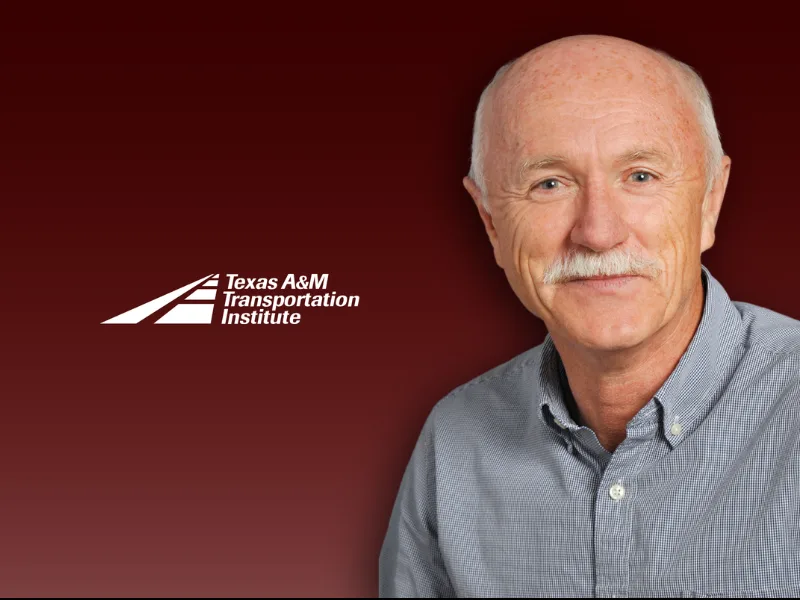Tom Scullion Celebrates 45 Years with TTI
Tom Scullion, a Texas A&M Regents Fellow, Texas A&M Transportation Institute (TTI) Research Fellow and registered professional engineer in Texas, celebrated 45 years with TTI on Feb. 14, 2025.
Scullion holds a Bachelor of Science in physics and mathematics and a Master of Science in materials science from Sheffield University in the United Kingdom, as well as a Master of Business Administration from Texas A&M University. His current interests are in the areas of optimizing pavement rehabilitation, overlay design, non-destructive testing, corridor studies and forensic engineering. For years, Tom served as head of the Flexible Pavement Program, overseeing a team of full-time researchers, experienced technicians and both graduate and undergraduate students. He remains active in many areas of pavement research including non-destructive testing, soil stabilization, full depth reclamation, rubblization of concrete pavements, perpetual pavement design, forensic engineering, mechanistic pavement design and overlay design.
“Tom’s impact on pavement research in Texas and beyond is immeasurable,” says Stephen Sebesta, TTI research scientist and division head of the Pavement and Materials Division. “His work in nondestructive testing and pavement evaluation has helped shape the way agencies approach roadway rehabilitation and design. His ability to bridge research with real-world applications has made a lasting difference for TxDOT and the transportation industry.”
Scullion is a leading expert in using nondestructive testing to detect defects in engineering structures. He routinely uses falling weight deflectometers (FWD) to measure structural strength and ground-penetrating radar (GPR) to locate subsurface defects. Studies conducted on in-service pavements across Texas have demonstrated the ability of high-speed, air-coupled GPR to accurately measure layer thickness, detect damage in surface and base layers, and identify areas of low density within asphalt layers.
Scullion supervised the development of GPR interpretation software and trained the Texas Department of Transportation (TxDOT) on its applications, helping the agency integrate the technology into its routine pavement rehabilitation projects since 2004. He also led the development of MODULUS 7, an analysis program used daily by TxDOT designers to evaluate the structural health of pavements.
In the early 1980s, Scullion proposed the first structural strength strategy based on FWD measurements, which was later incorporated into TxDOT’s Pavement Evaluation Systems (pre-Pavement Analyst). He played a pivotal role in implementing TxDOT’s low-speed traveling deflectometer, the Total Pavement Acceptance Device (TPAD)—the only known project-level traveling deflection device for concrete pavements. In 2004, he assisted TxDOT and the Federal Highway Administration in evaluating the first generation of traffic-speed deflectometers (TSDD), conducting tests on instrumented sections and comparing results from FWD, TPAD and TSDD devices.
Over the years, Scullion has worked closely with TxDOT to conduct major corridor studies and forensic investigations to identify causes of pavement failures, develop solutions for these causes, and identify new technologies or specifications to improve the state of the practice. He continues to assist districts in evaluating pavement issues and determining the best repair strategies. Currently, he is leading efforts to continue traffic speed deflection applications in Texas, develop rehabilitation alternatives for roadways across Texas, and foster further development of cold recycling pavement rehabilitation solutions. Scullion also continues to provide expert guidance on flexible pavement structural analysis and design, working closely with TxDOT’s Maintenance Division and providing pavement design training.
The forensic investigations have become an integral part of TTI’s research and development cycle. The primary goals are to identify the cause of pavement failures, determine immediate corrective actions, and — most importantly — develop strategies to prevent future issues. This final step has led to numerous innovative studies. Nationally recognized advancements, such as the Balanced Mix Design concept, thermal imaging for hot mix quality, crack-attenuating mixtures, and sulfate testing procedures, were all developed through TTI forensic studies and have been implemented by our sponsors.
“Tom’s dedication to advancing pavement technology and his commitment to supporting TxDOT and other transportation agencies have been invaluable,” says Darlene Goehl, associate agency director overseeing TTI’s Infrastructure Group. “His leadership and expertise have shaped innovative solutions that improve the safety, durability and efficiency of Texas roadways. We are incredibly grateful for his contributions over the past 45 years—and for the impact he will continue to make in the years ahead.”




